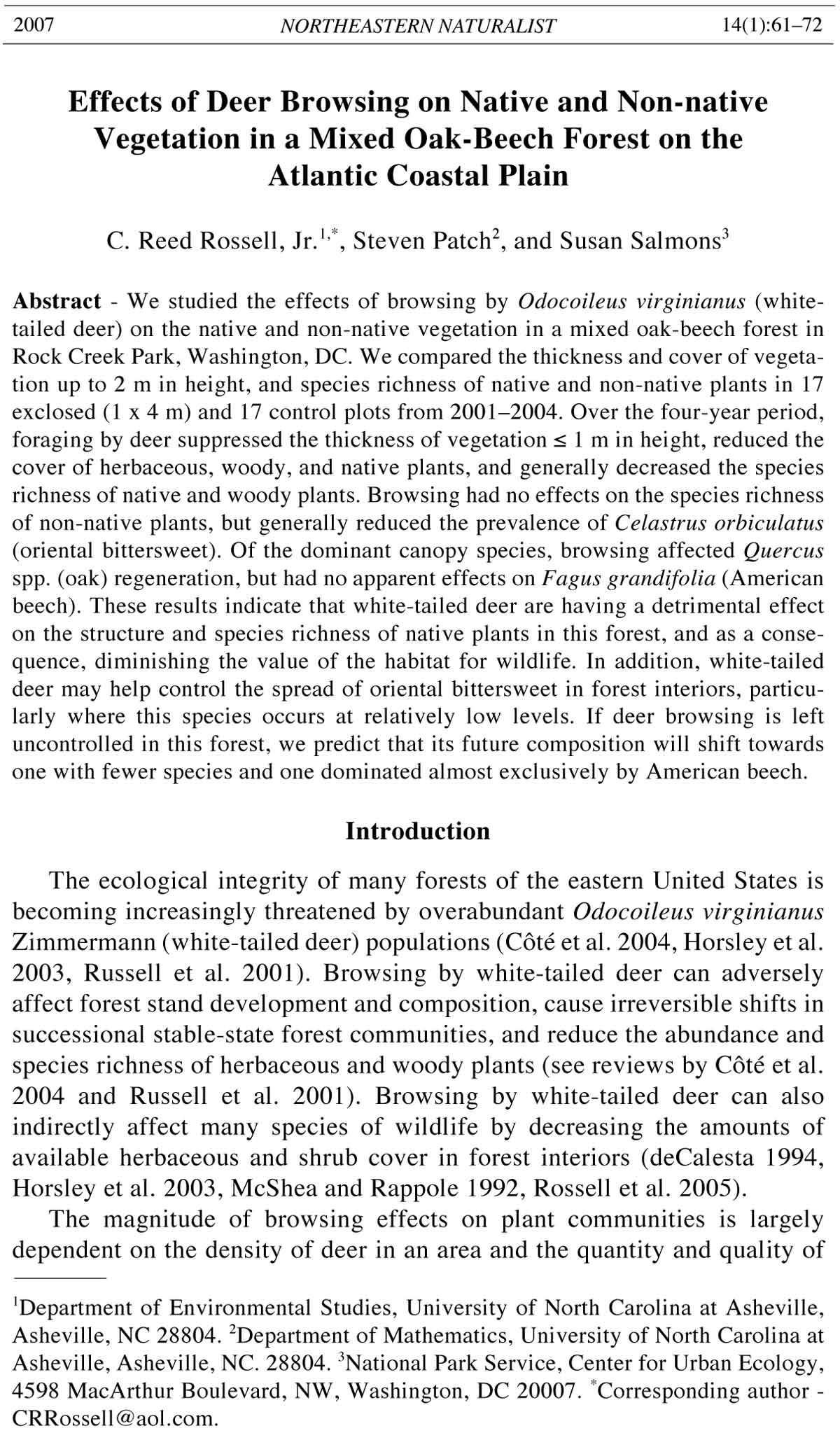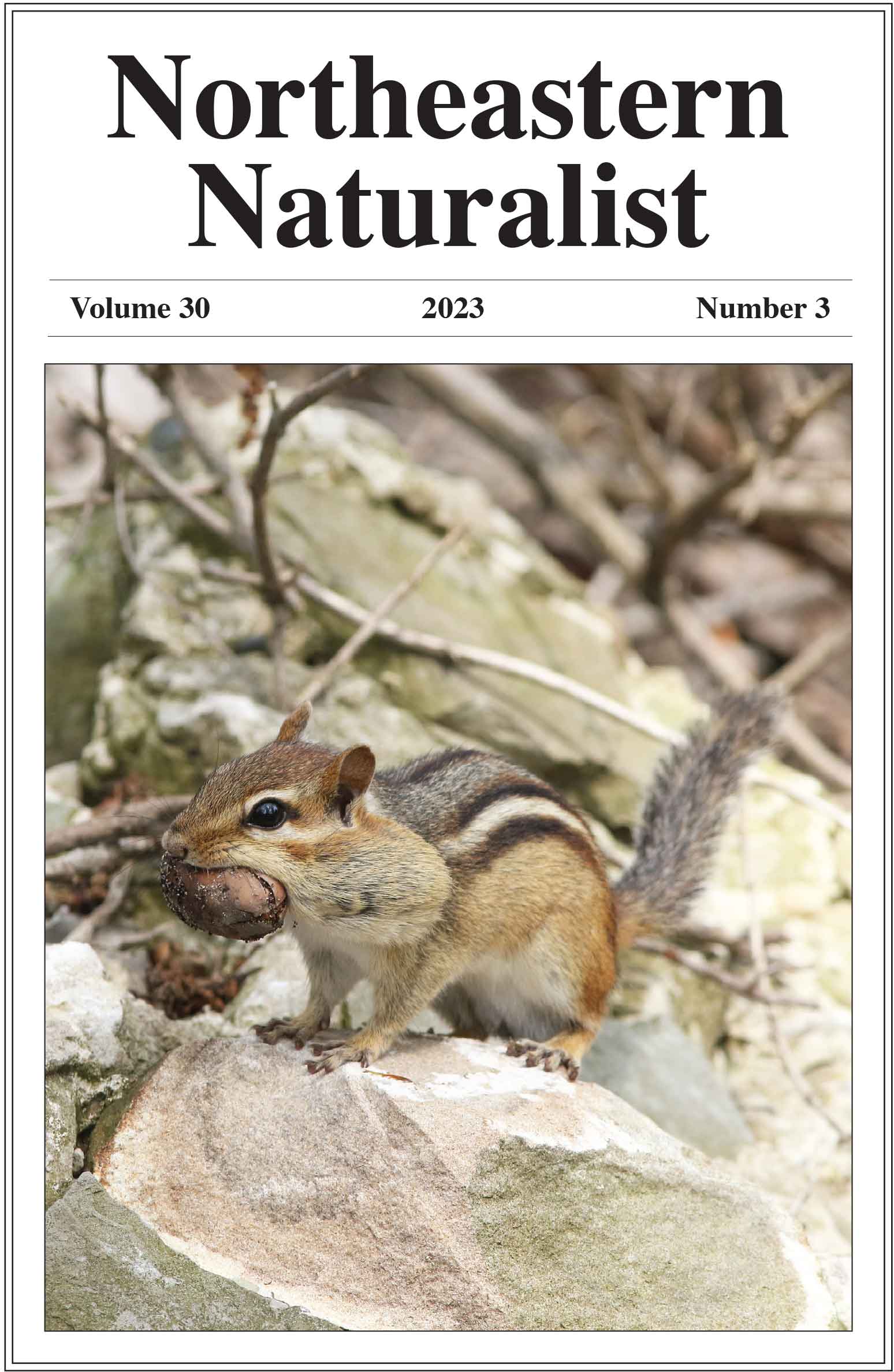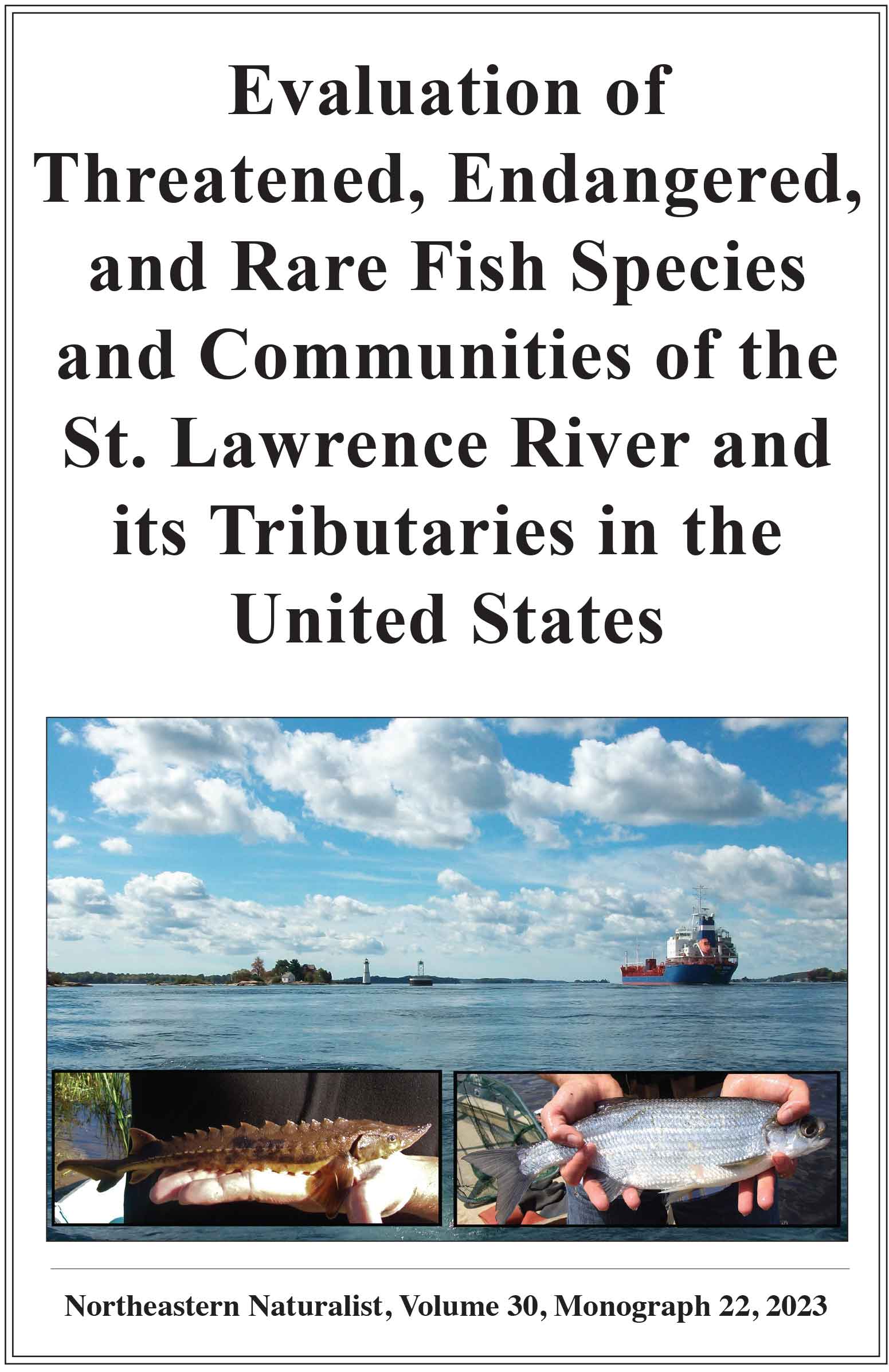Effects of Deer Browsing on Native and Non-native Vegetation in a Mixed Oak-Beech Forest on the Atlantic Coastal Plain
C. Reed Rossell, Jr., Steven Patch, and Susan Salmons
Northeastern Naturalist, Volume 14, Issue 1 (2007): 61–72
Full-text pdf (Accessible only to subscribers.To subscribe click here.)

Access Journal Content
Open access browsing of table of contents and abstract pages. Full text pdfs available for download for subscribers.
Current Issue: Vol. 30 (3)

Check out NENA's latest Monograph:
Monograph 22









2007 NORTHEASTERN NATURALIST 14(1):61–72
Effects of Deer Browsing on Native and Non-native
Vegetation in a Mixed Oak-Beech Forest on the
Atlantic Coastal Plain
C. Reed Rossell, Jr.1,*, Steven Patch2, and Susan Salmons3
Abstract - We studied the effects of browsing by Odocoileus virginianus (whitetailed
deer) on the native and non-native vegetation in a mixed oak-beech forest in
Rock Creek Park, Washington, DC. We compared the thickness and cover of vegetation
up to 2 m in height, and species richness of native and non-native plants in 17
exclosed (1 x 4 m) and 17 control plots from 2001–2004. Over the four-year period,
foraging by deer suppressed the thickness of vegetation 1 m in height, reduced the
cover of herbaceous, woody, and native plants, and generally decreased the species
richness of native and woody plants. Browsing had no effects on the species richness
of non-native plants, but generally reduced the prevalence of Celastrus orbiculatus
(oriental bittersweet). Of the dominant canopy species, browsing affected Quercus
spp. (oak) regeneration, but had no apparent effects on Fagus grandifolia (American
beech). These results indicate that white-tailed deer are having a detrimental effect
on the structure and species richness of native plants in this forest, and as a consequence,
diminishing the value of the habitat for wildlife. In addition, white-tailed
deer may help control the spread of oriental bittersweet in forest interiors, particularly
where this species occurs at relatively low levels. If deer browsing is left
uncontrolled in this forest, we predict that its future composition will shift towards
one with fewer species and one dominated almost exclusively by American beech.
Introduction
The ecological integrity of many forests of the eastern United States is
becoming increasingly threatened by overabundant Odocoileus virginianus
Zimmermann (white-tailed deer) populations (Côté et al. 2004, Horsley et al.
2003, Russell et al. 2001). Browsing by white-tailed deer can adversely
affect forest stand development and composition, cause irreversible shifts in
successional stable-state forest communities, and reduce the abundance and
species richness of herbaceous and woody plants (see reviews by Côté et al.
2004 and Russell et al. 2001). Browsing by white-tailed deer can also
indirectly affect many species of wildlife by decreasing the amounts of
available herbaceous and shrub cover in forest interiors (deCalesta 1994,
Horsley et al. 2003, McShea and Rappole 1992, Rossell et al. 2005).
The magnitude of browsing effects on plant communities is largely
dependent on the density of deer in an area and the quantity and quality of
1Department of Environmental Studies, University of North Carolina at Asheville,
Asheville, NC 28804. 2Department of Mathematics, University of North Carolina at
Asheville, Asheville, NC. 28804. 3National Park Service, Center for Urban Ecology,
4598 MacArthur Boulevard, NW, Washington, DC 20007. *Corresponding author -
CRRossell@aol.com.
62 Northeastern Naturalist Vol. 14, No. 1
available forage (Côté et al. 2004, Russell et al. 2001). However, the impacts
of browsing do not appear to be consistent across the range of white-tailed
deer (Russell et al. 2001). For example, some studies have reported that
browsing had no effects on plant survival and growth, while others have
reported that browsing caused only sporadic effects depending on the year,
season, site, or deer densities (Russell et al. 2001).
The tolerance of a plant community to browsing may vary within community
types and among physiographic regions, because of differing abiotic
and biotic factors of the environment (Augustine and McNaughton 1998,
Côté et al. 2004, Horsley et al. 2003, Liang and Seagle 2002). Most studies
investigating the effects of deer browsing, however, have been conducted in
the north-central or northeastern United States (Russell et al. 2001). There is
a lack of information on the impacts of white-tailed deer for most physiographic
regions of the middle-Atlantic states, and no studies have been
conducted in mixed oak-beech forests of the Middle Atlantic Coastal Plain
(nomenclature of physiographic regions follow Halls [1984]).
In addition to the impacts of deer browsing, the proliferation of invasive
non-native plants is also becoming a widespread problem throughout many
forests of the eastern United States (D’Antonio et al. 2004). Few studies,
however, have investigated the role white-tailed deer play in controlling or
perpetuating the spread of non-native plants. Vellend (2002) documented
that white-tailed deer are effective at dispersing viable seeds of invasive
Lonicera spp. (honeysuckle shrubs) through their feces in forests of upstate
New York. In Georgia, Stromayer et al. (1998) reported that Ligustrum
sinense Lour. (Chinese privet) vigorously responded to winter deer browsing
by increasing its growth by factors of 4–6 times in the spring, thereby
reducing the available space for native plants to thrive. In this study, we used
deer exclosures to investigate the effects of browsing on the structure and
general composition of native and non-native vegetation in a mixed oakbeech
forest in the Middle Atlantic Coastal Plain.
Study Area
We conducted our study in the mixed oak-beech forest of Rock Creek
Park (RCP; 39°02'N, 77°05'W), located in northwest Washington, DC.
Rock Creek Park is located on the southern edge of the Middle Atlantic
Coastal Plain (Halls 1984). The park is surrounded by an urbanized landscape,
and no hunting is permitted within its boundaries. Densities of
white-tailed deer in RCP are considered moderate (23 ± 3.1 deer/km2,
estimated during the fall 2002 using spotlight counts with distance sampling;
Bates 2003), but a prominent browse line is developing throughout
the forests of the park. Topography of RCP is flat to rolling on the
uplands, with relatively steep slopes that descend to a narrow floodplain
along the creek. Elevations of the park range from sea level to 125 m.
Data from the Southeast Regional Climate Center, Columbia, SC, indicate
average annual temperatures of the area range from 7.6 to 19.6 °C,
with an average annual rainfall of 109 cm.
2007 C.R. Rossell, Jr., S. Patch, and S. Salmons 63
The park contains 1000 ha of forests, of which 730 ha are mature mixed
oak-beech forest (The Nature Conservancy [TNC] 1998). The mixed oakbeech
forest generally occurs on the dry mesic and mesic slopes of the park
(TNC 1998). Associated soils are primarily Manor and Glenelg loam, and
are characterized as relatively deep, well- to excessively-drained, and underlain
by acidic bedrock (Smith 1976). Dominant canopy species include
Quercus alba L. (white oak), Fagus grandifolia L. (American beech),
Liriodendron tulipifera L. (tulip poplar), various Quercus spp. (oaks) and
Carya spp. (hickories), Prunus serotina Ehrh. (black cherry), and Fraxinus
americana L. (white ash). Dominant subcanopy and shrub species include
Cornus florida L. (flowering dogwood), Ilex opaca Ait. (American holly),
Viburnum acerifolium L. (malpeleaf viburnum), and Lindera benzoin (L.)
Blume (spicebush). Common herbaceous plants include Podophyllum
peltatum L. (mayapple), Arisaema triphyllum (L.) Schott (jack-in-the-pulpit),
Polystichum acrostichoides Michx. (Christmas fern), and Osmorhiza
berteroi DC. (sweet cicely). Lonicera japonica Thunb. (Japanese honeysuckle),
Celastrus orbiculatus Thunb. (oriental bittersweet), and Hedera
helix L. (English ivy) are common to locally abundant in some areas of the
forest (TNC 1998).
Methods
We investigated the effects of browsing in the mixed oak-beech forest
from 2001 to 2004. Vegetation data were collected from 17 exclosures and
17 control plots during June –August each year of the study. Deer
exclosures (1.5 x 4.5 m) were constructed during the late summer of 2000
and consisted of welded wire fence, 2.4 m tall, with mesh openings (5 x 10
cm) and gaps along the bottom of the fence to allow passage of small
mammals. Exclosures were randomly located in the interior of the forest
using the random location generator in ArcView 3.1 (Environmental Systems
Institution, Redlands, CA). Within each exclosure, a vegetation plot
(1 x 4 m) was established. Each exclosed plot was paired with a control
plot of the same size. To help ensure that the vegetation between treatments
(control vs. exclosed plots) was homogeneous, control plots were
placed 1.5 m from exclosed plots, and located on the side of the exclosure
that most closely resembled the vegetation in the exclosed plot.
Vegetation thickness of three height intervals (bottom: 0–30 cm, middle:
31–110 cm, top: 111–200 cm) was estimated within each plot (Hays et al.
1981). A grid of 10- x 10-cm squares (0.8 m wide x 2 m tall) was suspended
outside the long edge of each plot. A recorder stationed 1 m in front of the
grid counted the number of squares covered by vegetation to the nearest 0.25
square. The grid and recorder moved five times across the plot to obtain
estimates for the entire plot. Plant cover (plants < 2 m in height) was
estimated in each plot using the point-intercept method (Hays et al. 1981). A
grid of 200 points was placed over each plot. Grid points were located every
20 cm along parallel rows at 10-cm intervals. All plants intercepted under a
64 Northeastern Naturalist Vol. 14, No. 1
point were identified to species and categorized as native or non-native as
well as herbaceous or woody (i.e., vines, shrubs, and trees). Each plant was
recorded only once per grid point.
To analyze the effect of exclosed plots on vegetation thickness, a repeated-
measures, linear mixed model was fit to the data. The response
variable was the number of squares covered by vegetation on the vertical
grid. To improve normality and homoscedasticity of the residuals, a natural
logarithmic transform was applied to the count of covered cells after adding
1.0 to each to keep responses well-defined. The model was applied separately
to each height interval. The predictor variables for the model were
treatment (control vs. exclosed plots), year (considered as a categorical
variable), and their two-way interaction. Plots were considered a random
factor, and the treatment-by-plot combinations were considered as a repeated
factor. The correlation structure of observations measured at the
same treatment-by-plot combinations in different years was modeled with a
first-order autoregressive covariance matrix because it fit the sum of height
intervals better than an unstructured covariance or a compound symmetric
covariance according to Aikake’s Information Criterion (AIC). The mixed
procedure in version 9.02 of Statistical Analysis System (SAS) was used to
fit the models.
A similar statistical method was used to examine the effect of exclosed
plots on plant cover. A linear mixed model was fit to the sum of all native
species within a plot, all non-native species within a plot, all herbaceous
species within a plot, and all woody species within a plot. Responses were the
sum of the counts for each point on the grid for each of the categories
described above. As with vegetation thickness, a natural logarithmic transform
was applied to the number of cells after adding 1.0. The predictor
variables were treatment, year, and their interaction. Unlike the analysis of
vegetation thickness, an unstructured covariance structure was used because it
had the lowest AIC of the three structures considered for each of the data sets.
Plant species richness within each plot was assessed using a count of the
number of species that were assigned at least one count of plant cover. A
linear mixed model was fit to the count of all native species within a plot, all
non-native species within a plot, all herbaceous species within a plot,
and all woody species within a plot. With the exception of the non-native
species, which contained a high percentage of 0 counts, the residuals from
the raw counts fit the assumptions of the model. Therefore, no transformation
was applied. The predictor variables were treatment, year, and their
interaction. A compound symmetric covariance structure was used because
it had the lowest AIC of the three structures considered for each of the
categories described above. A significance level of 0.05 was used as criteria
of statistical significance for all tests. Because sample sizes were too small
to statistically analyze the effects of browsing on individual species, qualitative
assessments of the effects on the major species in the study were
conducted using descriptive statistics.
2007 C.R. Rossell, Jr., S. Patch, and S. Salmons 65
Results
Vegetation thickness
There were no significant interactions between treatment and year for
vegetation thickness at any height interval (all P > 0.24), indicating that the
differences in vegetation thickness between treatments were relatively constant
over the study (Table 1). There was a significant effect of treatment
(controls vs. exclosed plots) on vegetation thickness of the bottom (P <
0.001) and middle intervals (P < 0.001). Thickness of vegetation was consistently
less in the bottom and middle intervals of the controls than the
exclosed plots (Table 1). A similar pattern was evident for the top interval as
well, but the differences between treatments were not significant (P = 0.21;
Table 1). There was a significant effect of year on vegetation thickness of the
bottom interval (P < 0.001). During 2002, overall thickness (controls and
exclosed plots averaged together) of the vegetation in the bottom interval
was less than the other years of study (Table 1). No significant effects of
year were found on vegetation thickness of either the middle or top intervals
(all P > 0.11).
Plant cover
There were no significant treatment-by-year interactions for any of the
categories, indicating that the differences in cover between treatments were
consistent throughout the study (all P > 0.05). Significant effects of treatment
were found on native (P < 0.001), herbaceous (P = 0.04), and woody
plant cover (P = 0.002). Plant cover for each of these categories was substantially
less in the controls than in the exclosed plots over the study period
(Fig.1). Cover of non-native plants also was less in the controls than in the
exclosed plots, however, the difference was not significant (P = 0.29). There
was a significant effect of year on the cover of herbaceous plants (P = 0.003).
Overall cover of herbaceous plants (control and exclosed plots averaged
together) was less in 2002 and 2003 than in 2001 and 2004 (Fig. 1). No
significant effects of year were found on plant cover for any of the other
categories (all P > 0.05).
Table 1. Mean percentages (SD) of vegetation thickness for three height intervals (bottom: 0–30
cm, middle: 31–110 cm, top: 111–200 cm) estimated in 17 control and 17 exclosed plots (1 x 4
m) in a mixed oak-beech forest in Rock Creek Park, Washington, DC, from 2001–2004.
Year
Height interval Treatment 20011 2002 2003 2004
Bottom Control 6.8 (6.2) 4.2 (4.2) 6.3 (7.7) 8.5 (9.9)
Exclosed 12.9 (10.9) 9.3 (8.7) 16.5 (13.0) 18.4 (14.0)
Middle Control 1.5 (2.1) 1.0 (1.3) 1.1 (1.4) 0.8 (1.0)
Exclosed 5.6 (5.0) 3.3 (3.4) 3.9 (4.1) 4.4 (3.7)
Top Control 2.0 (2.4) 1.2 (1.7) 1.6 (1.4) 1.3 (1.8)
Exclosed 4.5 (5.0) 2.8 (3.5) 2.1 (2.6) 1.8 (2.2)
1Only 15 pairs of plots were measured in 2001.
66 Northeastern Naturalist Vol. 14, No. 1
Species richness
A total of 31 herbaceous species (29 native and 2 non-native) and 44
woody species (32 native and 12 non-native) were recorded during our
study. There were significant treatment-by-year interactions on the number
of native (P = 0.004) and woody species (P = 0.014), indicating that treatment
effects on native and woody species varied from year to year. In 2001,
treatment effects on native and woody species were less than the treatment
effects during other years of the study (year effects: native species P < 0.001,
woody species P < 0.001; Fig. 2). No significant effects of treatment, year,
or treatment-by-year interactions were found on the number of non-native or
herbaceous species (all P > 0.057).
Individual species response
The total number of plots occupied by the major native and non-native
woody species is presented in Table 2. Of the native species, general
treatment effects were apparent on black cherry, hickories, mapleleaf
viburnum, oaks, and white ash. The prevalence of each of these species,
with the exception of oaks and white ash, were consistently less in the
controls than in the exclosed plots each year of the study (Table 2). General
treatment effects for oaks and white ash were evident by the fourth and
third years of the study (Table 2). No apparent treatment effects were
Figure 1. Mean percent plant cover from 17 control and 17 exclosed plots (1 x 4 m) in
a mixed oak-beech forest in Rock Creek Park, Washington, DC, from 2001–2004.
Open bars are control plots, filled bars are exclosed plots. Error bars represent
standard deviations.
2007 C.R. Rossell, Jr., S. Patch, and S. Salmons 67
observed on American beech, spicebush, or tulip poplar, as the occurrence
of these species remained stable or increased in the controls relative to the
exclosed plots during the four years of study (Table 2). Of the non-native
species, general treatment effects were evident on the prevalence of oriental
bittersweet (Table 2). No treatment effects were apparent for English
ivy or Japanese honeysuckle (Table 2).
Discussion
Browsing adversely affected the thickness of vegetation up to 1 m in
height by suppressing the density of vegetation to levels lower than would be
expected in the absence of deer. The greatest effects of browsing occurred
nearest the ground (0–30 cm), where the response of the vegetation to the
exclusion of deer was most pronounced. Vegetation thickness at the bottom
interval increased almost 30% in the exclosed plots over the four years of
study, while it remained relatively unchanged in the controls (Table 1).
Understory thickness is an important habitat component to many species
of wildlife. It has been positively correlated with the abundance of a variety
of small mammals (Dueser and Shugart 1978), with the abundance and
species richness of breeding birds (McShea and Rappole 1992), and with the
abundance and species diversity of wintering birds (Zebehazy and Rossell
Figure 2. Mean number of species from 17 control and 17 exclosed plots (1 x 4 m) in
a mixed oak-beech forest in Rock Creek Park, Washington, DC, from 2001–2004.
Open bars are control plots, filled bars are exclosed plots. Error bars represent
standard deviations.
68 Northeastern Naturalist Vol. 14, No. 1
1996). It also has been negatively correlated with predation rates of artificial
ground nests (Greenberg et al. 1992). Only one comparable study has examined
the effects of browsing in relation to vegetation thickness at different
heights (in a five-year exclosure study); Rossell et al. (2005) found that deer
browsing (67 deer/km2) significantly reduced the thickness of the understory
up to 0.5 m in height in three forest-types on the Piedmont Plateau in
northern Virginia. Other studies also have reported that deer browsing negatively
affects the understory structure of a forest by reducing woody stem
densities and heights (e.g., Alverson et al. 1988, Banta et al. 2005, Comisky
et al. 2005, Healy 1997, Hough 1965, Tilghman 1989).
Deer browsing affected herbaceous plant cover in a similar manner to
vegetation thickness. Herbaceous cover is a habitat requisite for a variety of
small mammals (Rossell and Rossell 1999) and many ground nesting birds
such as Vermivora chrysoptera Linnaeus (Golden-winged Warbler; Rossell
et al. 2003). Herbaceous cover averaged 31% less in the controls than in the
exclosed plots during our study (Fig. 1). Similar impacts of browsing on
herbaceous cover have been reported throughout forests of the eastern
United States. Rossell et al. (2005) reported that browsing decreased forb
cover by at least 30% over a five-year period in three forest-types in northern
Virginia. Hough (1965) in a 20-year photographic study, reported that deer
herbivory progressively decreased herbaceous cover in a virgin hemlock-
Table 2. Number of plots occupied by the major native and non-native woody species in 17
control and 17 exclosed plots (1 x 4 m) in a mixed oak-beech forest in Rock Creek Park,
Washington, DC, during 2001–2004.
Species Treatment 2001 2002 2003 2004
Native
Black Cherry Control 3 1 0 3
Exclosed 4 3 3 7
Beech Control 9 5 10 10
Exclosed 8 9 9 10
Hickories Control 0 1 0 0
Exclosed 5 5 5 5
Mapleleaf viburnum Control 5 5 1 1
Exclosed 9 8 9 10
Oaks Control 2 2 1 1
Exclosed 2 2 2 4
Spicebush Control 9 8 7 8
Exclosed 10 8 8 8
Tulip poplar Control 0 0 1 3
Exclosed 5 1 1 2
White ash Control 3 2 0 0
Exclosed 1 4 3 3
Non-native
English ivy Control 3 3 3 3
Exclosure 3 3 3 3
Japanese honeysuckle Control 4 3 6 4
Exclosed 5 5 6 6
Oriental bittersweet Control 1 0 2 0
Exclosed 3 5 5 5
2007 C.R. Rossell, Jr., S. Patch, and S. Salmons 69
hardwood forest in northwestern Pennsylvania. In contrast, Banta et al.
(2005), deCalesta (1994), Horsley et al. (2003), and Tilghman (1989) found
no impacts on herbaceous cover at five different deer densities (0–30 deer/
km2) in uncut stands of Allegheny hardwood forests in northwestern and
north-central Pennsylvania. However, Banta et al. (2005), deCalesta (1994),
and Horsley et al. (2003) did report changes in the species composition of
the herbaceous layer; forbs and flowering plants decreased with increasing
deer densities, while unpalatable ferns and grasses increased.
Woody plant cover is a commonly measured attribute in habitat studies
because of its importance to wildlife (Morrison et al. 1992). Forest stands with
moderate to dense woody cover are preferred habitats of a variety of animals
including Terrapene carolina Linnaeus (Eastern Box Turtle; Rossell et al.
2006), small mammals (Dueser and Shugart 1978, Kitchings and Levy 1981),
and forest-dwelling birds (James 1971). Browsing negatively affected the
amounts of woody plant cover in our study. Over the four-year period, woody
plant cover averaged 47% less in the controls than in the exclosed plots
(Fig. 1). Other studies, although not directly measuring woody plant cover,
have reported that browsing can severely impact the understory structure of a
forest interior (e.g., Alverson et al. 1988, Banta et al. 2005, Hough 1965,
Rossell et al. 2005, Tilghman 1989).
Browsing generally decreased the richness of native and woody plants
over the four years of our study. The effects of browsing, however, were less
pronounced during the first year of the study than the other years for both
native and woody species, as indicated by the significant interactions of
treatment-by-year. A similar pattern of effects was also evident on the
richness of herbaceous plants; however, because of the large standard deviations
associated with the means, the effects were not statistically significant.
Other deer exclosure studies also have reported browsing negatively affected
the richness of native woody and herbaceous plants (Augustine and
Frelich 1998, Healy 1997, Horsley et al. 2003, Liang and Seagle 2002,
Rossell et al. 2005, Tilghman 1989).
The finding that browsing had no effects on the richness of non-native
plants should be viewed tentatively because of the sporadic distribution of
relatively few species within our study plots. Alliaria officianalis Andrz. ex
Bieb. (garlic mustard) and Duchesnea indica (Andr.) Focke (false strawberry)
were the only non-native herbs in our study. These species occurred in
5 of 34 plots (15%) and accounted for less than 0.4% of the total herbaceous
cover. Garlic mustard is considered invasive and has the capability of
spreading throughout a forest’s interior (Miller 2003). Browsing had no
apparent effect on this species, as it occurred in one control and one exclosed
plot in the first year of the study, and in three controls and two exclosed plots
in the fourth year of the study. In our study, browsing generally decreased
the prevalence of oriental bittersweet. This finding, however, warrants further
investigation and suggests that deer may play a role in controlling this
invasive plant in a forest interior, particularly when this species occurs at
low levels. Oriental bittersweet is considered shade intolerant and is most
70 Northeastern Naturalist Vol. 14, No. 1
often found in forest openings and along forest edges (Miller 2003). Its
utility to wildlife is reportedly very limited (Martin et al. 1961), with its
seeds dispersed primarily by birds and a few mammals (Miller 2003).
All the major native woody species in our study appeared to be impacted
by deer browsing, with the exception of American beech and spicebush. These
results are in general accordance with Liang and Seagle (2002), who also
reported that browsing did not suppress American beech or spicebush in a
riparian forest in Maryland. In our study, American beech was the most
prevalent tree species that occurred in the study plots, and the least affected by
browsing (Table 2). Also notable was the lack of oak regeneration in any of
the study plots, especially when considering that oaks were the dominant
canopy species in the forest (Bates 2003). During the first year of the study, Q.
prinus L. (chestnut oak) was the only oak species present in either the controls
or exclosed plots. By the fourth year of the study, however, oak regeneration
had responded to the exclusion of deer, with the exclosed plots containing one
chestnut oak, one Q. rubra L. (red oak), and two white oak seedlings. These
findings suggest that white-tailed deer may be shifting the future composition
of this forest towards one with fewer species and one dominated by American
beech, thus making it vulnerable to beech bark disease.
Most of the response of the vegetation to the exclusion of deer occurred
during the first year of the study, and then leveled off in subsequent years.
This type of response may be indicative of vegetation released from browsing
under a closed canopy, where light may be a limiting factor for the
continual growth of vegetation. Similar response patterns were reported for
vegetation thickness and forb cover in a deer exclosure study in an oakhickory
and bottomland hardwood forests in Virginia (Rossell et al. 2005). It
is possible that the results of our study do not reflect the effects of browsing,
but rather reflect differences in vegetation that occurred at the beginning of
our study, with exclosed plots having denser vegetation than controls. We
believe that this is unlikely, however, and that differences in vegetation
between treatments was minimized as a result of the relatively large sample
size in our study (N = 17), and because treatment plots (controls vs.
exclosed) were located in close proximity to each other (1.5 m apart).
Deer density during our study was 23 deer/km2. This density is substantially
greater than the estimated carrying capacities of 6–10 deer/km2 for
upland hardwood forests of the South Atlantic Coastal Plain (Newsome
1984) and 15.4 deer/km2 for the Virginia Piedmont (Whittington 1984). This
further supports our conclusions that white-tailed deer are having a significant
impact on the understory structure and species richness of native plants
in this mixed oak-beech forest. Based on the results of this study, we suggest
that there is a need to initiate an active deer management program, which
controls the level of browsing to mitigate the effects on the vegetation.
Acknowledgments
We thank D. Pavek for helpful comments on the statistical analysis and for
reviewing the manuscript, K. Ferebee for providing funds for the exclosures through
2007 C.R. Rossell, Jr., S. Patch, and S. Salmons 71
a National Park Service Natural Resource Planning and Protection grant, and J.
Hughes, A. Houser, and seasonal staff of Rock Creek Park for collecting and
managing the vegetation data.
Literature Cited
Alverson, W.S., D.M. Waller, and D.S.L. Solheim. 1988. Forest too deer: Edge
effects in northern Wisconsin. Conservation Biology 2:348–358.
Augustine, D.J., and L.E. Frelich. 1998. Effects of white-tailed deer on populations
of an understory forb in fragmented deciduous forests. Conservation Biology
12:995–1004.
Augustine, D.J., and S.J. McNaughton. 1998. Ungulate effects on the functional
species composition of plant communities: Herbivore selectivity and plant tolerance.
Journal of Wildlife Management 62:1165–1182.
Banta, J.A., A.A. Royo, C. Kirschbaum, and W.P. Carson. 2005. Plant communities
growing on boulders in the Allegheny National Forest: Evidence for boulders as
refugia from deer and as a bioassay of overbrowsing. Natural Areas Journal
25:10–18.
Bates, S. 2003. Deer population: Report FY 2002. National Capital Region, National
Park Service, Washington, DC. 21 pp.
Comisky, L., A.A. Royo, and W.P. Carson. 2005. Deer browsing creates rock refugia
gardens on large boulders in the Allegheny National Forest, Pennsylvania.
American Midland Naturalist 154:201–206.
Côté, S.D., T.P. Rooney, J. Tremblay, C. Dussault, and D.M. Waller. 2004. Ecological
impacts of deer overabundance. Annual Review of Ecological and Evolutionary
Systems 35:113–147.
D’Antonio, C.M., N.E. Jackson, C.C. Horvitz, and R. Hedberg. 2004. Invasive plants
in wildland ecosystems: Merging the study of invasion processes with management
needs. Frontiers in Ecology and Management 10:513–521.
deCalesta, D.S. 1994. Effect of white-tailed deer on songbirds within managed
forests in Pennsylvania. Journal of Wildlife Management 58:711–718.
Dueser, R.D., and H.H. Shugart, Jr. 1978. Microhabitats in a forest-floor small
mammal fauna. Ecology 59:89–98.
Greenberg, C.H., C.R. Rossell, Jr., and D.B. Johnson. 1992. Predation on artificial
nests in hurricane-created gaps and adjacent forest of the southern
Appalachians,.Journal of the North Academy of Science 118:181–188.
Halls, L.K. 1984. White-tailed Deer Management and Ecology. Stackpole Books,
Harrisburg, PA. 870 pp.
Hays, R.L., C. Summers, and W. Seitz. 1981. Estimating wildlife habitat variables.
US Fish and Wildlife Service. FWS/OBS-81-47. 111 pp.
Healy, W.M. 1997. Influence of deer on the structure and composition of oak forests
in central Massachusetts. Pp. 249–266, In W.J. McShea, H.B. Underwood, and
J.H. Rappole (Eds.). The Science of Overabundance: Deer Ecology and Population
Management. Smithsonian Institution Press, Washington, DC.
Horsley, S.B., S.L. Stout, and D.S. deCalesta. 2003. White-tailed deer impact on the
vegetation dynamics of a northern hardwood forest. Ecological Applications
13:98–118.
Hough, A.F. 1965. A twenty-year record of understory vegetational change in a
virgin Pennsylvanian forest. Ecology 46:370–373.
James, F.C. 1971. Ordinations of habitat relationships among breeding birds. Wilson
Bulletin 83:215–236.
Kitchings, J.T., and D.J. Levy. 1981. Habitat patterns in a small mammal community.
Journal of Mammalogy 62:814–820.
72 Northeastern Naturalist Vol. 14, No. 1
Liang, S.Y., and S.W. Seagle. 2002. Browsing and microhabitat effects on riparian
forest wood seedling demography. Ecology 83:212–227.
Martin, C.A., H.S. Zim, and A.L. Nelson. 1961. American Wildlife and Plants: A
Guide to Wildlife Food Habits. Dover Publications, New York, NY. 500 pp.
McShea, W.J., and J.H. Rappole. 1992. White-tailed deer as keystone species within
forested habitats of Virginia. Virginia Journal of Science 43:177–186.
Miller, J.H. 2003. Nonnative invasive plants of southern forests: A field guide for
identification and control. USDA Forest Service General Technical Report SRS-
62. 93 pp.
Morrison, M.L., B.G. Marcot, and R.W. Mannan. 1992. Wildlife-habitat relationships.
University of Wisconsin Press, Madison, WI. 343 pp.
Newsome, J.D. 1984. Coastal Plain. Pp. 367–380, In L.K. Halls (Ed.). White-tailed
Deer Ecology and Management. Stackpole Books, Harrisburg, PA.
Rossell, C.R., Jr., and I.M. Rossell. 1999. Microhabitat selection by small mammals
in a southern Appalachian fen in the USA. Wetlands Ecology and Management
7:219–224.
Rossell, C.R., Jr., S.C. Patch, and S.P. Wilds. 2003. Attributes of Golden-winged
Warbler territories in a mountain wetland. Wildlife Society Bulletin 31:1099–1104.
Rossell, C.R., Jr., B. Gorsira, and S. Patch. 2005. Effects of white-tailed deer on
vegetation structure and woody seedling composition in three forest types on the
Piedmont Plateau. Forest Ecology and Management 210:415–424.
Rossell, C.R., Jr., I.M. Rossell, and S. Patch. 2006. Microhabitat selection by Eastern
Box Turtles (Terrapene c. carolina) in a North Carolina mountain wetland.
Journal of Herpetology 40:280–284.
Russell, L.F., D.B. Zippin, and N.L. Fowler. 2001. Effects of white-tailed deer
(Odocoileus virginianus) on plants, plant populations, and communities: A review.
American Midland Naturalist 146:1–26.
Smith, H. 1976. Soil survey of District of Columbia. USDA Soil Conservation
Service, Washington, DC.
Stromayer, K.A.K., R.J. Warren, A.S. Johnson, P.E. Hale, C.L. Rogers, and C.L.
Tucker. 1998. Chinese privet and the feeding ecology of white-tailed deer: The
role of an exotic plant. Journal of Wildlife Management 62:1321–1329.
The Nature Conservancy (TNC). 1998. NBS/NPS vegetation mapping program:
Vegetation classification of Rock Creek Park. The Nature Conservancy, International
Headquarters, Arlington, VA. 44 pp.
Tilghman, N.G. 1989. Impacts of white-tailed deer on forest regeneration in northwestern
Pennsylvania. Journal of Wildlife Management 53:524–532.
Vellend, M. 2002. A pest and an invader: White-tailed deer (Odocoileus virginianus
Zimm.) as a seed dispersal agent for honeysuckle shrubs (Lonicera L.). Natural
Areas Journal 22:230–234.
Whittington, R.W. 1984. Piedmont Plateau. Pp. 355–366, In L.K. Halls (Ed.). Whitetailed
Deer Ecology and Management. Stackpole Books, Harrisburg, PA.
Zebehazy, L.A., and C.R. Rossell, Jr. 1996. Winter bird use of eastern white pine
(Pinus strobus) stands with different structural characteristics. Journal of the
Elisha Mitchell Scientific Society 112:94–97.












